What Does The Tai Chi Symbol Mean?
Dec 09, 2023
The Tai Chi symbol appears as a simple design of intertwined black and white. However, this ancient emblem, deeply rooted in Chinese philosophy, carries profound meanings that transcend its visual simplicity. Known as the Yin-Yang symbol, it epitomizes the duality of existence, encapsulating a universe of interpretations within its swirling design. This symbol is not merely a visual representation; it is a philosophical guide that reflects the core principles of balance and harmony. It underscores the interconnectedness and interdependence of opposite forces and their seamless flow into each other, a concept central to the practice and philosophy of Tai Chi. In exploring the Tai Chi symbol, we delve into a rich tapestry of cultural, spiritual, and philosophical insights.
Table of Contents
Origins of the Tai Chi Symbol

Tracing its roots in ancient Chinese philosophy, the Tai Chi symbol, often recognized as the Yin-Yang symbol, holds a significant place in the historical context. Originating from Taoist ideologies, it embodies an understanding of the universe’s duality and balance. This symbol has evolved over millennia, intertwining with various aspects of Chinese culture, from religious practices to martial arts. Its representation in historical texts and artifacts indicates a deep-rooted philosophical significance, offering insights into the ancient Chinese worldview. The symbol’s enduring presence highlights its importance in understanding the natural balance of the world, a concept central to Taoist teachings and practices.
Understanding the Tai Chi Symbol
The Tai Chi symbol, iconic in its simplicity, features a circle divided into a swirling black-and-white design. Each half contains a dot of the opposite color, symbolizing the interconnectedness of opposing forces. The black area, known as Yin, represents elements like passivity, darkness, and femininity. Conversely, the white area, Yang, embodies activity, light, and masculinity. This visual representation captures the essence of dualism—the idea that opposite forces are not only interconnected but also interdependent. The symbol serves as a philosophical guide, illustrating how contrasting elements coexist and give rise to each other, forming a dynamic and harmonious whole.
The Symbol’s Significance in Tai Chi

In Tai Chi, the Yin-Yang symbol transcends its visual appeal, embedding itself deeply in the practice’s philosophical and practical aspects. It represents the core principle of Tai Chi: the harmonious balance of opposing yet complementary forces. Practitioners of Tai Chi interpret the symbol as a reminder of the fluidity between strength and flexibility, action and stillness, and the physical and mental aspects of the martial art.
The philosophical implications of the symbol in Tai Chi extend to understanding life’s complexities. It teaches that true strength lies in the balance and harmony of contrasting elements, a philosophy that resonates not only in martial arts but in the broader spectrum of human experiences.
Yin and Yang: The Dual Principles
The Yin and Yang, fundamental concepts in Chinese philosophy, represent dual but complementary forces in the universe. Yin, characterized by darkness, passivity, and femininity, is often depicted as the black segment in the Tai Chi symbol. In contrast, Yang represents light, activity, and masculinity, depicted as the white part. These principles are not static or absolute; rather, they are dynamic and constantly influence each other.
For example, day (Yang) turns into night (Yin), symbolizing the natural cycle of light and darkness. Similar to how activity (Yang) and rest (Yin) balance one another in human life, this illustrates the need for equilibrium in our daily routines. By understanding these principles, one gains insight into the natural balance and interconnectedness of all things.
Balance and Harmony
In Tai Chi, balance and harmony are not just concepts but lived experiences. The Tai Chi symbol, with its intertwined Yin and Yang, serves as a visual representation of these ideals. Practitioners of Tai Chi strive to embody this balance through their movements, which are designed to align and harmonize the flow of internal energy, or 'Qi'. The gentle, flowing motions encourage a state of mental calm and physical equilibrium, reflecting the harmony between mind and body. This balance extends beyond the individual, influencing how one interacts with others and the environment. Tai Chi teaches that harmony within oneself leads to harmony in one's surroundings, promoting a peaceful and balanced way of living.
The Symbol in Martial Arts
Tai Chi, often perceived as a gentle form of exercise, is deeply rooted in martial arts. At its core, this symbol, representing Yin and Yang, embodies the martial philosophy of balance and counterbalance. In physical terms, this translates to understanding and harnessing opposing forces within combat. For instance, when an opponent exerts force, a Tai Chi practitioner learns to yield (Yin) rather than resist (Yang), using the aggressor's energy against them.
Similarly, the flowing movements in Tai Chi, depicted by the swirling design of the symbol, emphasize fluidity over rigidity, teaching practitioners to move seamlessly between defense and attack. Thus, this symbol serves not just as an emblem but as a fundamental martial principle guiding the art's techniques and strategies.
Spiritual Aspects of the Symbol
In spiritual contexts, the Tai Chi symbol transcends its physical interpretation, offering insights into the duality of existence. It encourages a harmonious balance between the spiritual (Yin) and material (Yang) aspects of life. The sign symbolizes inner calm and stability, making it essential in meditation and mindfulness. Practitioners often meditate on the symbol to understand the interplay of opposites in life: light and dark, action and inaction, the external world, and the internal self.
By contemplating the seamless flow of Yin into Yang and vice versa, individuals can cultivate a deeper sense of connectedness with the universe and a more profound understanding of their place within it. The Tai Chi symbol, in this spiritual journey, becomes a guide to achieving a state of holistic well-being and spiritual awareness.
Conclusion
The Tai Chi symbol is more than just a part of martial arts heritage; it is a universal emblem of balance and duality. It represents a philosophical understanding that resonates across various aspects of life, from spirituality to physical wellness. By embracing Yin and Yang, this symbol helps us live harmoniously by combining conflicting elements. As we reflect on the depth and breadth of its significance, one might wonder: How can we apply the timeless wisdom of the Tai Chi symbol to find balance in our own lives?
FAQs
1. What exactly does the Tai Chi symbol represent?
This symbol, also known as Yin-Yang, portrays a balance of opposing yet complementary forces. It's a circle, split into swirling black and white halves, each containing a dot of the opposite color.
2. How is this symbol integrated into martial arts?
In martial arts, particularly Tai Chi, this symbol guides the balance of soft and hard techniques. It teaches harmonizing physical power with mental and emotional agility during practice.
3. What do the black and white sections in the symbol mean?
The black section, Yin, symbolizes aspects like passivity, femininity, and darkness. Contrarily, the white section, Yang, represents activity, masculinity, and light, emphasizing the concept of complementary forces.
4. Can this symbol aid in meditation practices?
Yes, this symbol is often employed in meditation to focus on achieving balance. It aids in harmonizing one's internal spiritual and external material worlds through contemplation.
5. Does the Tai Chi symbol extend beyond Chinese culture?
While deeply rooted in Chinese philosophy, the Tai Chi symbol has gained worldwide recognition. It's universally used to depict the balance and interconnectivity of life's dual aspects.







